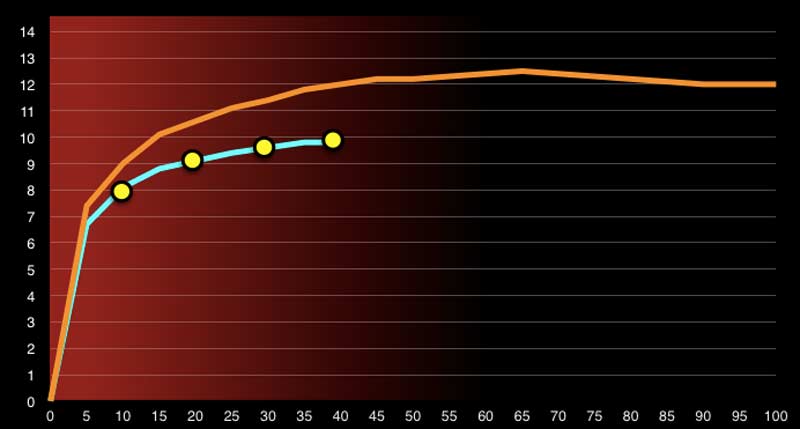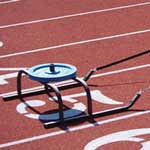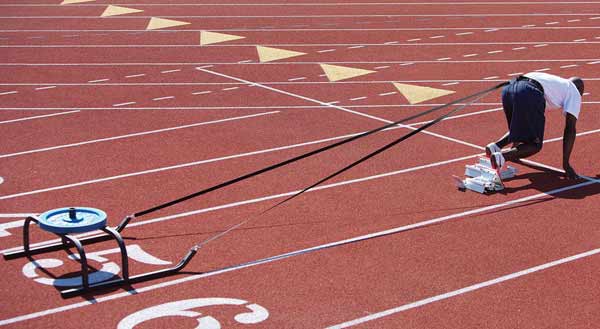
By Carl Valle
Adjusting Loads for Performance
Every year a few studies are published in the sport science journals investigating the use of sleds on performance. A few months before publication the abstract is tweeted or shared on social media, reigniting the age old debate of what the optimal load should be to get faster. The earlier article on weight sleds focused on general guidelines when using sprint sleds, and suggested the use of electronic timing over percentage of an athlete’s bodyweight. This article will build on the concepts of the earlier article regarding using a velocity and kinematic approach to improving acceleration, while introducing some novel concepts such as potentiation and using split timing. It is important to note the goal of the article is not to promote or dispel dogma and myths, but to create an applied formula to develop acceleration from 5-60m.
One of the best inventions for sprint coaches is the Sprint Start Sled by Gill Athletics. Not only is it good for sprinters who have blocks, but the design and quality of the product is perfect for athletes wanting to work on higher velocity sprints. Too heavy a sled the elastic qualities are lost and it becomes a pyramid building punishment rather than a speed session.
Problems with the 10% Body Weight Rule
Rehashing the earlier article slightly, one of the common debates is the “10% rule” with resistance sprints, specifically with weighed sleds. The argument is that the best way to calculate appropriate loads is to use a percentage of one’s bodyweight. So, for a simple example, a 200-pound athlete would use a 20 pound load. A few problems with the golden rule of 10% weight, causing many coaches to question the efficacy of the guideline.
Noted performance expert Henk Kraaijenhof pointed out several holes in this approach in terms of precision, since different sleds and surfaces will have different friction scores. So the question arises about the value of simple added weight compared to the entire set-up of surface, sled type, and weight added.
Another pitfall with just gross weight of an athlete is each athlete has a power to weight ratio, or better phrased speed to weight ratio. A 200-pound lean athlete that runs 4.00 in the 30m sprint is a different beast than a 4.25 athlete that weighs 200 pounds. While both athletes may jump similar heights and distances, they are not even the same speed profile. Also, we may see both athletes running similar initial acceleration times in the first 10m or even first 5m, but even end times are not enough to use for loading decisions.
Adopting the Velocity Approach
Mentioned in some circles, the lesser used version of the 10% rule is the concept that the load of the sled should not drop more than 10% with an athlete’s speed, specifically their performance time, The rule seems slightly wiser since on paper it looks more applied, but it’s way too vague and overly simplistic. One main reason I don’t like the 10% rule as a black and white guideline is that it’s a blanket suggestion for everyone, and for every distance in acceleration. I do like the direction of the rule since we are measuring more useful metrics that are better evaluators of training. When working on speed development, we should be looking at speed indices. Imagine if we adjusted the challenge of conditioning tests based on bodyweight rather than time? Sounds foolish but I believe the rationale behind the percentage of bodyweight might have stemmed from convenience of the measurements of a weighted plate rather because of the limitations of access to electronic timing.
The access to electronic timing, especially set-ups that can analyze common splits, allows coaches to make better decisions of loading sleds. At first it may be tempting to look at velocity based on loaded and unloaded sprints, it’s better to look at the improvement of the workouts over the course of phases and seasons, rather than looking for a specific drop off percentage. I have found the 10% rule to be a little crude, but experience and research show that loads closer to 10% are far better than massive loads, and some literature pointed out that 12-15% can make an improvement. Some current research while insightful, still misses the big picture and fails to see if the athlete improves their ability to go from point A to point B. Perhaps it’s better to look past how velocity is lost from the load, and see how the improvement from training from loading is in addition to a common strength training program. Research is limited at times because they are trying to control and sometimes isolate variables, and training is more a recipe rather than one ingredient. The effectiveness of one variable in research (usually sled weight) washes out in a complete program, one reason why coaches still stick to the same loads because advanced athletes adapt less as they are closer to their ceiling.
Composition of Sprinting and other Modalities
Sled training with different loads rarely, if at all, includes a solid mix of strength training and other modalities such as plyometrics. Coaches are not really interested in sled training alone, but how sleds can be added into a complete speed development program. A better comparison than looking at different sled loads and speed development is to see a conventional strength training program in addition to sled loads. The reason is simple, many heavy sled proponents forget that those who employ light sprints use heavy weights as well, negating much of the improvements coming from one modality (one variable) only study. We learned in the article on plyometrics and speed development is that the contraction speeds of jump training match the longer ground contact times of early acceleration. Similar to general weight training, plyometrics are providing an avenue to assist the athlete in getting faster, so the impact of training loads on sled is going to be marginal.
A safe bet, or arguably a better question, is to investigate the velocity changes against unloaded sprints in a comprehensive training program, and see what common improvement patterns one sees. With heavy strength and power training taking care of the maximal and high-velocity contractile demands, balancing out the program with higher speeds on paper makes more sense than to stay in the slower region of the force-velocity curve. The SAID principle, or specific adaptations to imposed demands is a timeless reminder that speed usually requires speeds close to the performance wanted. Slowing down the athlete too much to get a “strength quality”, be it specific strength or special strength, doesn’t hold weight (no pun intended) when coaches simply are looking for faster athletes. A good strength training program will take care of the “heavy lifting”, and sleds should be light enough to get elastic contractions that are sufficient in preparing athletes for fast sprinting.
Before You Break the Rules, Master Them First
Back to the 10% velocity rule, the question is what is the ideal speed drop off? Not only are coaches and athletes responsible for the drop in velocity from the load, but fatigue is also a factor in managing the training process. One additional monkey wrench is that early acceleration is more consistent and easier to reproduce than near maximal velocities, and it appears that athletes are able to reproduce top speed later in the season. If we are looking to improve performance, sleds seem to be best used for improving the 5-30m range because the change in speed is more evident in the first 30m rather than the last 30m of 60m. So what load is appropriate here? I would argue that sticking to the conventional 10% rule becomes tricky when each athlete is unique in their abilities of acceleration and top speed. A good start may be evaluating the impact of the training load on each 10m split of acceleration, rather than just total time of the run. Coaches and athletes need to see the interaction of the sled in all parts of the acceleration curve, not just the end result. After an athlete is timed in their loaded and unloaded sprint, a more precise adjustment can be decided later. It should be noted that one shouldn’t stress too much and attempt to fine tune the load excessively as we are looking to make reasonable and appropriate adjustments based on velocities. Patience tinkering with a smart load is far better than looking for a magic bullet.
Adjusting Loads for the Perfect Sled Workout
Recent and classic research on applied forces from sprinting can lead to misinterpreting the influence of training from horizontal and vertical forces. Some advocates of special techniques promote exercises, specific routines, and even focusing on muscle groups. Unfortunately no matter how great the ideas and theories are, at the end time between point A to point B is the name of the game. The most straightforward approach of seeing how interventions improve one’s times trumps and kinematic or kinetic description or idea. It’s essential to provide possible mechanisms to why methods work, but the methods have to be proven to work over and over before the evangelism process can begin. While it’s sometimes interesting to dive into the sport science, the goal of training is to improve outcomes, not entertain bored coaches.
The simplest way to profile and select loads for speed development is to time an unloaded sprint and compare that profile to normative data and see possible areas of concern. Most coaches just want to improve all areas, and while no specific recipe exists, it does make sense to focus on a load that doesn’t cause any split within 0-40m to be excessively disrupted. Remember most of the acceleration in loaded sprints ends earlier than unloaded sprints and several reasons are known to cause this pattern. Without getting into posture and vertical force discussion, we know that any sled is likely to hold a sprinter in place more than a free sprint, an unloaded run that allows gradual rise in posture. After timing both sprint options, one can start loading the sled and look for the decay in speed overall and in specific areas of the speed curve. Each athlete is unique and different abilities and areas of strength will create individual need for prescription. A good rule of thumb is to make sure each split is faster than the previous, and that the drop off in speed is not too much that the athlete is spending too much exposure to speeds that don’t elicit future benefits. A good measuring stick is seeing an improvement in testing at the end of a phase acutely, and personal bests in either time, load with same velocity, or combination of the two.

Figure 2: Weighted Sled Load Characteristics
A good sled load fits two criteria. One, is that each successive split and repetition is getting faster per segment and not slowing down per run. Second is that the overall speed decrease is not more than about 10% of unloaded practice times. No exact number exists, but coaches are likely to want to keep loads light enough that the runs look, feel, and are measured to be close to what one is trying to achieve performance wise.
Closing Thoughts on Weighted Sleds
The goal of weighted sleds is obvious, improve speed via the specificity of overload and not turn it to a slow pushing exercise. When thinking about sled load, envision what improvements you feel will manifest early. The longer or slower the improvements from the sled, it’s likely not be coming from the track and the improvement will tend to be less. Several athletes may benefit by having loads beyond what is found to be successful in the literature, but correlation of fast athletes and heavy loads doesn’t equal causation. Several fast athletes are mediocre weight room trainers, and coaches simply revert to a safe and effective qualities of the sled. Very few athletes pull or get injured by the use of sleds empirically, so most coaches are far more comfortable letting an athlete do something hard rather than something fast if they are not getting hurt. If one adopts the mentality of seeing improvement in speed directly from the combination of sled loading protocols and holistic training protocols, sleds can be a useful tool in improving speed.
Please share this article so others may benefit.
[mashshare]




Hi my son is 8 weighs about 50 pounds and he has been running since 3. what age is a good time to begin sled training?
would suggest parachute or light sled about 5 pounds?